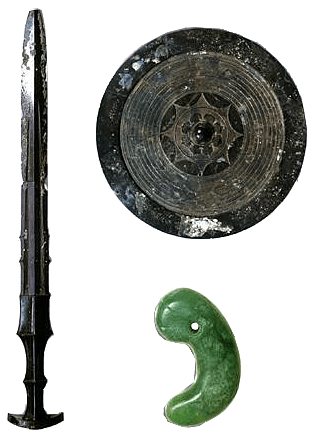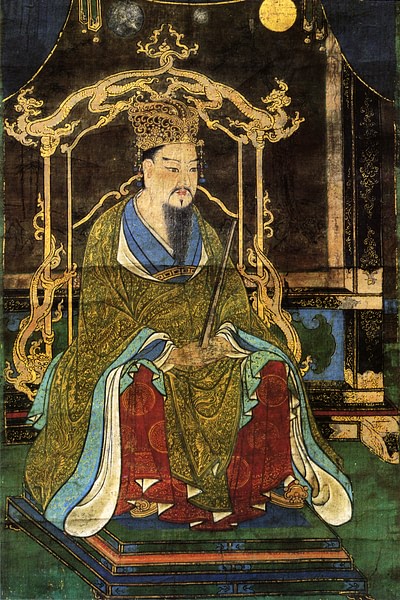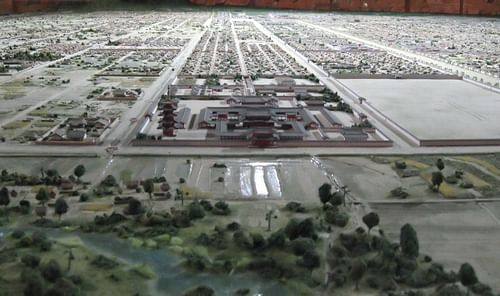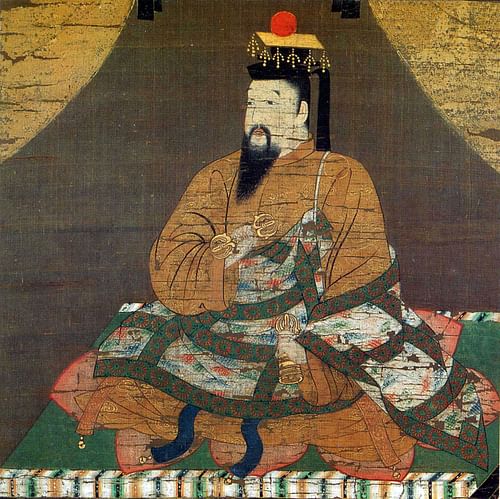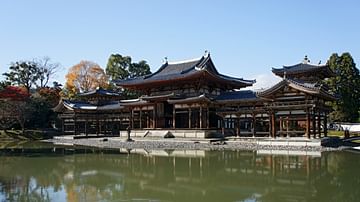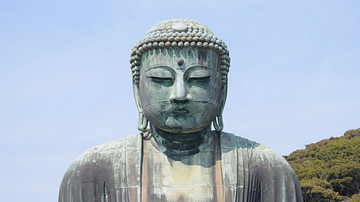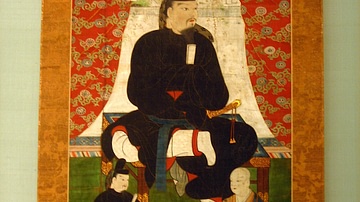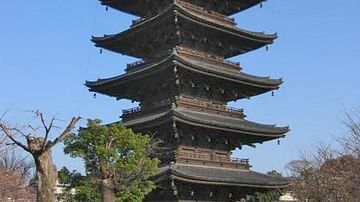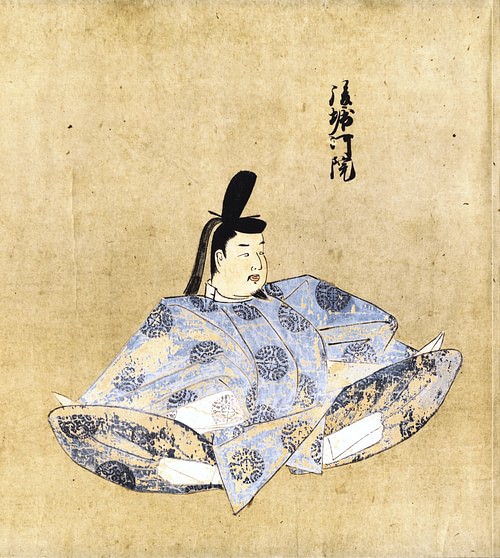
The Emperor of Japan is a position as the head of state which traditionally dates back to the 7th century BCE and the legendary figure of Emperor Jimmu (r. 660-585 BCE). Emperors came to be known as the Tenno or 'heavenly sovereign' in reference to the widely held belief that they were directly descended from the Shinto sun goddess Amaterasu.
From the 9th century CE, emperors and empresses began to be manipulated by officials of the Fujiwara clan, and by the 12th century CE, they were entirely replaced by warlords and shoguns as the de facto head of government. Despite the loss of power, the institution of the emperor remained a permanent fixture in Japanese politics, and imperial rulers continued to perform both a ceremonial function and to lend prestige and legitimacy to the rule of others. The emperors made a comeback with the 1868 CE Meiji Restoration and, as the position still continues today, it is regarded as the world's longest-surviving monarchy.
Sons of Heaven
From the 7th century CE, emperors began to be considered descendants of Shinto kami or spirits and so were the sons of heaven, as in the Chinese imperial model, and they, therefore, had a dual role of political and religious head of the country. Other ideas imported from China at that time included the structure of the state bureaucracy, the layout of palaces, and the renaming of deceased emperors using a posthumous reign name.
The first emperor, at least in legend, goes back much earlier than the 7th century CE. Emperor Jimmu, who took the throne in 660 BCE, is regarded as the great-great-grandson of Amaterasu the Shinto sun goddess and the conqueror of Yamato (Nara Prefecture). However, the first candidate for an actual historical emperor is usually taken as Emperor Sujin, although his reign dates vary enormously from either 97 to 30 BCE at the earliest to 318 CE at the latest. Due to these doubts over the early emperors, many historians now go for Emperor Kimmei (r. 539-571 CE) as the first ruler we can be absolutely sure of in terms of both historical existence and reign dates.
In Japan, the position of emperor was typically inherited through the male line (although the eldest son did not necessarily inherit the role), but there were nine female holders of the position, the first being Empress Suiko (r. 592-628 CE) and the last Empress Meisho (r. 1629-1643 CE). Emperors, together with the aristocratic elite families of Japan in a combination known as the kuge, wielded power in the Nara period (710-794 CE) and, to a lesser extent, in the Heian period (794-1185 CE).
The Imperial Regalia
The imperial regalia of Japan, the shinki, consists of a mirror, jewel, and sword. All three items, according to Japan's oldest text the Kojiki (712 CE), belonged to Amaterasu. The goddess then gave these precious items to her grandson Ninigi, the first ancestor of the imperial family, to help him establish his rule and authority over the world. The mirror, called the Yata, had been made by the gods to tempt Amaterasu out of her cave when she had hidden the sun from the world. The Yasakani is a fabulous jewel (or pearls or magatama beads), source of the ancient quarrel between Amaterasu and her brother Susanoo, the Shinto storm god. The sword, called the Kusanagi, is the great sword that Susanoo had plucked from a monster's tail and then given Amaterasu in reconciliation. Today, all three items are revered as key elements of Japanese history and they reside at the temple of Atsuta near Nagoya.
The Fujiwara & Insei Government
The role of the Japanese emperors was seriously challenged and eventually manipulated by the powerful Fujiwara clan who, from the mid-9th century CE, dominated Japan's government right through the Heian period. Members of the Fujiwara acted as regents (Sessho) to the emperors (especially those who took the throne as minors) and ensured their daughters married into the imperial family.
Even when the emperor reached adulthood, he was still advised by a new position, the Kampaku, which ensured the Fujiwara maintained their influence. To guarantee this situation was perpetuated, new emperors were nominated not by birth but by their sponsors and encouraged or forced to abdicate when in their thirties in favour of a younger and more easily manipulated successor. In total there would be 21 Fujiwara regents from 804 CE to 1238 CE.
The Fujiwara did not have everything their own way as some emperors fought back, notably Emperor Shirakawa (r. 1073-1087 CE) who attempted to assert his independence by abdicating in 1087 CE and allowing his son Horikawa to reign under his supervision. Shirakawa then ruled behind the scenes for over three decades. Emperors, from that time on, also created their own bureaucracy of power (In-no-Cho) similar to that of the Fujiwara clan. The In-no-Cho dealt with tax and land rights related to the throne, and some of its officials even worked in the government bureaucracy too.
This strategy of 'retired' emperors still, in effect, governing became known as 'cloistered government' (insei) as the emperor usually remained behind closed doors in a Buddhist monastery. The strategy of 'cloistered government', besides escaping the inconsequential ceremonies attached to the throne, also allowed the emperor to remove himself from the political intrigues of the capital and have the freedom to surround himself with his own advisors and not those forwarded by the Fujiwara.
One of the consequences of emperors giving out land rights was that the people who received them were courtiers and so often never left the capital. Delegating the management of their estates to local deputies, this resulted in an increase in the independence of the regions from the central government, which ultimately led to warlords exploiting the absence of control and depriving the state of valuable tax income. The Fujiwara clan had not gone away either, and they would eventually be replaced by similar clans created through the process of dynastic shedding (when an emperor or aristocrat had too many children they were removed from the line of inheritance). Thus, two important groups evolved, the Minamoto (aka Genji) and Taira (aka Heike) clans, each of which continued the policy of keeping emperors as distant as possible from real decision-making in the government. The result of this confusing bureaucracy and highly-centralised government was the arrival of the shoguns, the military dictators who would grasp for themselves political power in Japan's medieval period.
The Imperial Government
The emperor and his court were based first at Nara and then at Heiankyo (Kyoto) where there was an apparatus of imperial government. Below the emperor were the most important imperial princes, of which there were four:
- First Order (ippon)
- Second Order (nihon)
- Third Order (sanbon)
- Fourth Order (shihon)
Below these were 30 officials, all ranked in order, of other princes and Japanese government officials who held such titles as Senior Fourth Rank Upper-Grade (shosji-ijo) down to the very bottom of the pile, the Lesser Initial Rank Lower Grade (shosho—ige). These positions could go to men or women, but most were dominated by particular families, and the right of inheritance generally took precedence over ability.
The Japanese monarchy also presided over various departments within the imperial government, again arranged in a hierarchical manner. At the top were the Department of Shinto (Jingikan) and Council of State (Daijokan). Below these were two branches: the Controlling Board of the Left (Ubenkankyoku) and the Controlling Board of the Right (Sabenkankyoku) which supervised subsidiary ministries such as the Ministry of Ceremonial (Shikibusho), Ministry of War (Hyobusho) and Ministry of the Treasury (Okurasho).
The Imperial Palaces
Nara was the capital of Japan from 710 to 784 CE, and there a sprawling royal palace was built which was composed of two large enclosures. Emperor Shomu (r. 724-749 CE) would make the palace complex even grander. The Heijo Palace, as it was known, occupied 5% of the capital's total area. The walled compound had 12 gates, and within were not just the royal residences and banquet halls but also a large number of government buildings and offices. The royal buildings were in the Japanese style of plain wood and shingle roofs while the government ones had the striking red painted wood and green roof tiles of Chinese Tang architecture.
The capital of Japan then moved to Heiankyo in 794 CE, and the emperors moved, too. There a rectangular royal palace complex, known as the Greater Imperial Palace or Daidairi, was built. It measured around 1.2 x 1.4 km (7% of the city's total area) and was entirely surrounded by a high earth wall with 14 gates, the most important of which was the Vermillion Sparrow Gate. Inside were 200 structures of one kind or another, including palace residence buildings, banquet halls, government offices and storage facilities, Shinto shrines, pagodas, towers, covered walkways, gardens, trees, and streams. Architecture followed Chinese models, with the largest building being the Daigokuden or Great Hall of State, which contained the imperial throne room. The massive structure, with its green roof tiles, dolphin finials and vermillion pillars typical of all government buildings, measured 53 m (175 ft) by 20 m (65 ft). Burnt down by a fire, it was rebuilt on a smaller scale and is today part of the Heian Shrine.
Sponsors of the Arts
Emperors were important sponsors of the arts and architecture of Japan. For example, Emperor Temmu (r. 672-686 CE) built the original Yakushiji in 680 CE, which was later moved to Nara, Emperor Shomu (r. 724-749 CE) founded Todaiji temple, completed in 752 CE, and Emperor Uda (r. 887-897 CE) founded Ninna-ji temple in 888 CE.
In 905 CE the Kokinshu anthology of poems was compiled by Ki no Tsurayuki following a decree by Emperor Daigo (r. 897-930 CE). In 1205 CE Fujiwara no Sadaie compiled the Shin Kokinshu, another imperial poetry collection, this time commissioned by the retired emperor Go-Toba (r. 1183-1198 CE). Emperors even composed their own poems, as in this example by Emperor Jomei (r. 629-641 CE) from the Manyoshu anthology (c. 759 CE):
Countless are the mountains
in Yamato,
but perfect is
the heavenly hill of Kagu:
When I climb it
and survey my realm,
Over the wide plain
the smoke wreaths rise and rise,
over the wide sea
the gulls are on the wing;
a beautiful land it is,
Akitsushima,
the Land of Yamato.
(Keene, 96)
Challenge by the Shoguns
Emperors still enjoyed some power in the Kamakura period (1185-1333 CE) but by then a new political force was being established: the military class and, at the top of it, powerful warlords, shoguns (military dictators) and shogunal regents who commanded large armies to enforce their will. Following the appointment of the first shogun proper, Minamoto no Yoritomo in 1192 CE, the emperor's chief role was to bestow the title of shogun in order to give the holder of that position greater legitimacy. The emperors' significance declined further following the establishment by the Hojo family of shogunal regents and imperial regents from 1203 CE. The Hojo clan also began to intrigue in the succession of emperors and imposed legal restrictions on the emperor's role in government. The royal family was never wholly neglected though, and some shoguns even funded new palaces and granted the emperor a generous purse.
Attempts to Regain Power
Several emperors were disinclined to accept the absence of any real imperial power and made attempts to restore their status to what it had once been. Emperor Go-Toba took the opportunity to launch an attempted coup in 1221 CE - the so-called Jokyu Disturbance - which attempted to exploit the ill-feeling caused by the mysterious murder of the shogun. Lacking the military wherewithal to challenge Hojo Masako, the coup ultimately failed and ended in the then-retired emperor's exile to the distant Oki Islands. At least there he found the time and space to write his celebrated poems over the remaining 18 years of his life.
The disaffection caused by the necessity to keep Japan on a war footing during and after the Mongol Invasions of Japan in 1274 and 1281 CE was exploited by Emperor Go-Daigo (r. 1318-1339 CE) who sought to return to the good old days of the emperors before Minamoto no Yoritomo had started the shoguns. The emperor made two attempts to grab power, one in 1324 CE and another in 1331 CE. Neither was successful, and he was exiled for his troubles. Then came what has become known as the Kemmu Restoration, which lasted from 1333 to 1336 CE. Go-Daigo returned from exile and tried to enlist the aid of warlords disgruntled with the Kamakura Shogunate. The emperor found a willing ally in the traitorous army commander Ashikaga Takauji, actually sent by the Kamakura Shogunate to deal with Go-Daigo. Takauji attacked Heiankyo while another rebel warlord, Nitta Yoshisada, attacked Kamakura. Victorious, Takauji wanted to be the new shogun, but Go-Daigo refused to give him this title because he did not want to return to a position of subservience. Takauji defeated Go-Daigo's chief ally Yoshisada in battle and captured Heiankyo in 1336 CE; the former emperor was exiled for a second time (although he then established his own court at Yoshino, south of Heiankyo). Ashikaga Takauji found himself a more compliant emperor, Komyo, to act as the state's figurehead and became shogun in 1338 CE, thus inaugurating the Ashikaga Shogunate (aka Muromachi Shogunate, 1338-1573 CE).
The Northern & Southern Courts
Go-Daigo's decision to set up a rival imperial court at Yoshino meant that there were now two emperors in Japan, a system known as the 'Dual Courts' or 'Northern and Southern Courts' (1337-1392 CE). The courts were not only divided by geography but by the major and minor imperial lines, each one coming from one of two emperor brothers - the Jimyoin (descended from Go-Fukakusa, r. 1246-1259 CE) and the Daikakuji (descended from Kameyama, r. 1259-1274 CE). Each line had alternated the position of emperor during the Kamakura Shogunate (1192-1333 CE). The Northern Court (Hokucho) and Southern Court (Nancho) split, which lasted through the reigns of six northern emperors, would not be resolved until 1392 CE when the Southern Court ceased to exist after a promise was made and then broken to alternate emperors again between the two lines.
The Meiji Restoration & Modern Emperors
The Meiji Restoration - Meiji meaning 'Enlightened Rule' - came in 1867/8 CE when the troubled Tokugawa Shogunate faced increasing unrest across Japan. The shoguns were blamed for not dealing adequately with the threat from foreign powers like the United States and Great Britain. There were even popular slogans in the air such as sonno joi or 'revere the Emperor, expel the barbarians.' The last Tokugawa shogun, Tokugawa Yoshinobu (r. 1867-1868 CE) resigned and, at least in theory, full powers were restored to the emperors (although Emperor Meiji was only 15 years old at the time). The imperial palace was moved to Tokyo. Thereafter, the emperor was a constitutional monarch, although the military would manipulate the position until the end of the Second World War (1939-1945 CE). The 126th and current emperor of Japan is Naruhito, who ascended the throne in 2019 CE following his father's abdication.
This content was made possible with generous support from the Great Britain Sasakawa Foundation.
